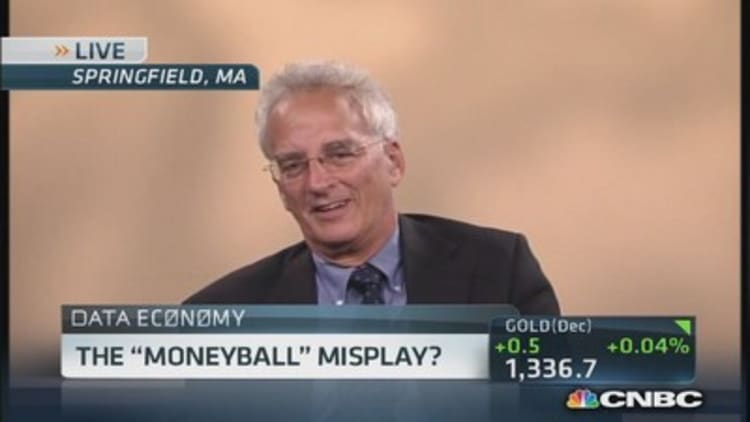What does a walk in baseball have to do with a mutual fund manager's inability to beat the S&P 500 index? More than you might think.
When Oakland As General Manager Billy Beane popularized the baseball science of sabermetrics—which actually dates to the mid-20th century—the "Moneyball" era of professional sports kicked into high gear. A stat like a player's ability to get on base—by walk or hit—otherwise known as on base percentage (OBP)—achieved the status of Major League Baseball golden formula. Players with an outlier's ability to "work a walk" were suddenly hot commodities on the free agent market, with OBP being bid up to bubble proportions. But once everybody in baseball got wise to that sabermetric trick, exploiting the same inefficiency in the market, could the advantage last?
That's where the mutual fund manager comes in. Once upon a time, the active manager in the domestic equity mutual fund world was on a pedestal, able to exploit inefficiencies in the market that made names like Peter Lynch of Fidelity Investments and Bill Miller of Legg Mason mutual fund world all-stars.
With the rapid spread of stock market and investing information, and advanced trading tools available in your home office at discount brokerage prices, it's been a long time since active domestic equity managers have been able to stand out and merit the high fees they charge relative to index funds—the inefficiencies once exploited are now known by everyone and their brother—everyone is, in essence, Billy Beane in this context.
And that's how a batter with an uncanny ability to get a walk in baseball can become an average performing, overpaid fund manager.
(Read more: A job that lets you hang with sports stars)
As leagues and teams embrace the data gospel to an even greater extent—and with a greater cost, though still relatively inexpensive in the billion-dollar world of sports—one economist said it's an open question if data will continue to be as significant a determinant of success.
"Delving hard into data can be successful in assessing talent in baseball, but a lot of the low-hanging fruit already has been picked," said Andrew Zimbalist, co-author of "The Sabermetric Revolution" and an economics professor at Smith College, speaking on CNBC's "Squawk Box."
"On base percentage, and walks being as important as hits, that was the easy work, and teams only had to pay $30,000 to hire somebody to tell them that," he said. "These days they are doing much more sophisticated, complicated stuff that will have a marginal impact that will be a lot smaller, and the people they are hiring cost a lot more."

But that's not even the biggest "Moneyball" misplay, according to Zimbalist.
(Read more: The geek algorithm of Monday Night Football)
In baseball, when all is said and done and the 27 outs recorded, data will still loom large, and the 27 outs has something to do with it—no other sport is as good a match for the big data approach as baseball. In baseball, there is not only a limited number of outs, but outcomes and situations—25 possibilities, to be exact, on every play, Zimbalist said. Baseball even has the largest sample size, at 162 games per season. At its most basic, "it's easy to isolate the production of an individual baseball player. You have a batter at the plate and a pitcher on the mound and a confrontation between two players," Zimbalist said.
Contrast that with what an NFL quarterback faces: 11 players on defense and 10 people either protecting him or going out on routes to get free, meaning that whether a QB completes a pass is dependent on all these other people. "They have a passer rating in football, but it's very inadequate. It says nothing about a QB running the ball or breaking free of lineman," Zimbalist said.
(Read more: The Vegas bookie is a cyborg)
In the NBA, a majority of teams now have analytics divisions—and data crunching has been a contributor to the success of teams like the Boston Celtics and Dallas Mavericks, where owner Mark Cuban is a major preacher from the data bully pulpit. Yet Zimbalist argues that it's much more difficult to gain an edge from data beyond baseball. "With football and basketball and hockey and soccer, the nature of the game is much more interactive, much more cooperative," he said. A point in basketball can be scored at any time from anywhere on the court.
If "Moneyball" is being mischaracterized and leading some professional sports teams to misleading conclusions about its value, Zimbalist doesn't think that on balance, professional sports franchises have gone too far off the data deep end yet—it's just the bang for their future data buck he openly questions. "No smart people in sports today think analytics or big data replaces the human element, the subjective element. Successful teams are embracing all methods," Zimbalist said.
Data analysis still works, it's just getting tougher to make a walk work in the "Moneyball" context.
—By Eric Rosenbaum, CNBC.com





